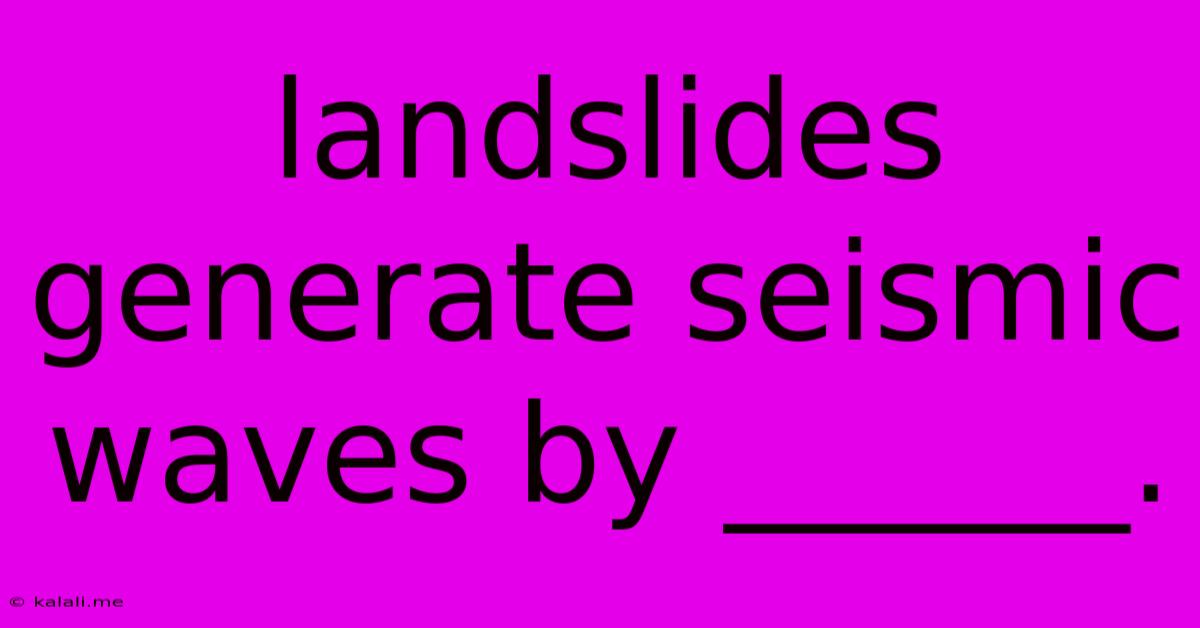Landslides Generate Seismic Waves By ______.
Kalali
Jun 12, 2025 · 3 min read

Table of Contents
Landslides Generate Seismic Waves by Mass Movement and Impact
Landslides, those dramatic and often devastating events involving the rapid downslope movement of soil and rock, generate seismic waves. This isn't just a minor tremor; the seismic signals produced can be significant, offering valuable information for monitoring landslide activity and even predicting future events. But how exactly do these massive earth movements create seismic waves? The answer lies primarily in mass movement and impact.
This article delves into the mechanics behind seismic wave generation during landslides, exploring the different factors influencing the intensity and characteristics of these waves. We'll examine the types of waves produced and their significance in landslide research and hazard assessment.
The Mechanics of Seismic Wave Generation
The process of a landslide generating seismic waves is complex but can be broken down into key stages:
-
Mass Movement: The primary mechanism is the sheer movement of the massive volume of soil and rock. As this mass accelerates downslope, it interacts with the surrounding earth, creating stresses and strains within the ground. These stresses are released as elastic waves, propagating outward from the source of the movement. Think of it like a giant, uncontrolled bulldozer pushing through the earth. The friction and deformation caused by this movement release energy in the form of seismic waves. Larger landslides, with greater volumes of moving material and higher velocities, generate stronger seismic signals.
-
Impact: When a landslide reaches the base of a slope or encounters obstacles, the impact generates a significant burst of energy. This impact can be even more efficient at creating seismic waves than the ongoing mass movement itself. Think of the impact as a sudden, concentrated release of energy, analogous to a small earthquake. The greater the mass and velocity, the more significant the seismic signal generated upon impact. This is particularly true for rock avalanches which often involve high-velocity collisions.
-
Type of Material: The type of material involved (soil, rock, debris) significantly impacts the seismic signal. Rock avalanches, for instance, often produce higher-frequency waves due to the rigid nature of the moving material compared to slower-moving debris flows. The heterogeneity of the landslide mass itself also affects wave propagation, causing scattering and attenuation of seismic energy.
Types of Seismic Waves Generated
Landslides typically generate both P-waves (primary waves) and S-waves (secondary waves), similar to those produced by earthquakes. P-waves are compressional waves, meaning they travel faster and cause particle motion in the same direction as wave propagation. S-waves are shear waves, travelling slower and causing particle motion perpendicular to the direction of wave propagation. The relative amplitudes and frequencies of these waves offer valuable clues about the characteristics of the landslide itself.
The Significance of Landslide-Generated Seismic Waves
The seismic waves generated by landslides are important for several reasons:
-
Early Warning Systems: Detecting these seismic signals can provide crucial early warning of an ongoing landslide, offering valuable time for evacuation or other mitigation efforts. Seismic monitoring networks are increasingly being used for this purpose.
-
Hazard Assessment: Analyzing the characteristics of the seismic waves can help researchers understand the dynamics of the landslide, such as its size, velocity, and the type of material involved. This information is vital for assessing future landslide hazards.
-
Remote Sensing: Seismic data can be combined with other remote sensing data (such as satellite imagery or aerial photographs) to create a more complete picture of landslide events and their impact.
In conclusion, landslides generate seismic waves through the combined effects of mass movement and impact. The characteristics of these waves provide valuable insights into landslide dynamics, enabling improved hazard assessment and the development of more effective early warning systems. Further research into the complex relationship between landslides and seismic waves is crucial for mitigating the risks associated with these devastating natural events.
Latest Posts
Latest Posts
-
Which Statement About Gases Is True
Jun 13, 2025
-
Female Reproductive System Questions And Answers Pdf
Jun 13, 2025
-
What Do You Mean By Bloody Sunday Class 9
Jun 13, 2025
-
Which Element Has The Highest Ionization Potential
Jun 13, 2025
-
The Biggest Gulf In The World
Jun 13, 2025
Related Post
Thank you for visiting our website which covers about Landslides Generate Seismic Waves By ______. . We hope the information provided has been useful to you. Feel free to contact us if you have any questions or need further assistance. See you next time and don't miss to bookmark.